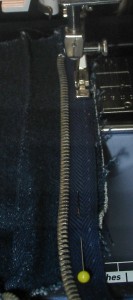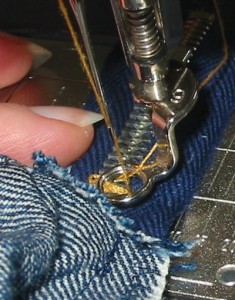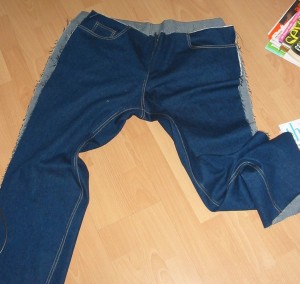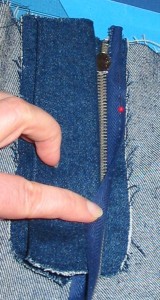Der zugesteckte Schlitz wird jetzt umgedreht, die linke Seite lingt jetzt oben.
Nun wird das noch lose Reißverschlußband am Schlitzbesatz festgesteckt. Aber wirklich nur am angeschnittenen Besatz, nicht an der Hose selber! (Versäubert sollte man die Schnittkante vorher haben…)
On we go…
The opening is pinned closed and now you turn everything around. Wrong side of fabric is on top.
Now you pin the still loose zippertape to the cut on facing. But only to the facing, not through all layers and to the pants! (It’s a very good idea to zigzag or serge the edge of the fabric before…)
 Jetzt den Besatz mit dem draufgestecketen Reißverschluß wieder aufklappen und auf dem Reißverschlußband entlang nähen.
Jetzt den Besatz mit dem draufgestecketen Reißverschluß wieder aufklappen und auf dem Reißverschlußband entlang nähen.
Wo genau auf dem Reißverschlußband ist ziemlich egal. Aber nur auf dem Besatz, nicht auf der Hose! Mit dem Reißverschlußfuß geht es einfacher.
Wie man hier noch mal sieht ist mein Besatz etwas schmal, der Reißverschluß paßt gerade drauf. Aber wie ich schon sagte… der Besatz sollte wenigstens einen Zentimeter breiter sein, wenn man Kappnähte macht.
Now you unfold the facing with the zipper tape pinned to it and stitch on the zipper tape.
Where exactely you stitch doesn’t matter. It’s only important, that you sew the tape only to the facing, not to the pant! And it’S easier when you use the zipper foot.
As you can see here ist my facing not really large, it’s not much larger than the zippertape. As I’ve said before… for flat felled seams the facing should be at least 1cm larger…
 Nach der ganzen Fiselarbeit kommt endlich wieder eine vernünftige Naht: Die Schrittnaht.
Nach der ganzen Fiselarbeit kommt endlich wieder eine vernünftige Naht: Die Schrittnaht.
Die Hose im Schritt links auf links zusammenstecken und dann die Seite nach oben legen, wo bereits die Stiche unterhalb des Reißverschlußschlitzes genäht sind.
Die Naht muß genau in dem letzten Stich des kleinen Nahtstückes enden bzw. anfangen.
Danach werden die Fäden beide auf die Seite des Unterfadens gezogen, dort verknotet und abgeschnitten. Ein paar Tropfen Frauycheck vorher schaden nicht.
After all those tiny steps a real seam, at last! The crotch seam.
Pin the pant pieces together, wrong sides facing. The side where the thicker thread of that tiny seam under the opening is visible has to be up. Then stitch.
Here is it important to start or end exactely in the last stitch of that mini seam. Then it loos like one continous seam.
The thread ends are brought to the side of the bobbin thread, then knotted and cut. Some drops of Fraycheck on the knots are nice for those who like security. (Like me…)
 Tja, und dann geht es wieder mit einem winzigen, aber sehr entscheidenden Schritt weiter:
Tja, und dann geht es wieder mit einem winzigen, aber sehr entscheidenden Schritt weiter:
Ich habe ja einen Reißverschluss verwendet, der deutlich länger ist als der Schlitz. Dadurch kann man den Schieber während des Nähens komplett aus dem Weg schieben und einfacher nähen.
Nun ist der Zeitpunkt gekommen, ihn zu kürzen. Aber vorher sollte man auf alle Fälle das Ende verriegeln.
Normalerweise genügt es dazu, einen Zickzackstich einzustellen, die Stichbreite auf etwas breiter als die Reißverschlusszähnchen stellen und die Stichlänge auf null.
Einige Stiche nähen, dann vernähen und den überstehenden Reißverschluss abschneiden.
Hier habe ich allerdings das Problem, daß meine Zähnchen sehr breit sind, breiter als der Zickzackstich. Also benutze ich meinen Stopffuß, stelle Stichlänge und Stichbreite auf null und bewege den Stoff von links nach rechts…. in meine extra starken Metallzähne sollte man nicht reinnähen, sonst ist die Nadel hin…
Again a small but very important step: I prefere zippers that are much longer than the opening, because then I can bring the slider part down while sewing and it is not in my way when I’m stitching.
So now is a good moment to cut what is too long. But not without securing the end first.
Normally you would just put the zipper under your pressure foot, choosing a zigzag stitch that is larger than the zipper teeth, set the stitch length to zero and make some stitches. Then secure the stitches and cutting the to much of the zipper.
Only in this case the zipper teeth are larger than my largest zigzag… :o) So back to my darning foot, setting stitch length and stitch width to zero and movin the zipper from left to right. And avoiding the extra strong metall teeth… because this would mean needle break…
 Und wenn das gemacht ist, kann man die Kappnaht im Schritt auch endlich fertig nähen.
Und wenn das gemacht ist, kann man die Kappnaht im Schritt auch endlich fertig nähen.
Dabei habe ich dann auch bemerkt, daß hier die 1,5cm Nahtzugabe wirklich nicht reichen. Schon nach dem ersten Tragen und erst recht nach dem ersten Waschen waren einige Fransen unauffällig mit Fraycheck zurückzuschieben und mit einigen dunkelblauen Handstichen durch die Kante zu befestigen.
Aber mit 2xm Nahtzugabe dürfte es prima gehen.
Und weil Aud meinte, es sei viel Mühe… liebe Aud, eine Kappnaht macht letztlich weniger Mühe als eine normale Naht, die man zwei Mal absteppt. Bei der Kappnaht muß ich nämlich nur zwei Mal drübersteppen, wenn ich eine normale Naht absteppe, dann sind es drei Durchgänge pro Naht. 😉
Jedenfalls sieht die Hose dann so aus wie auf dem Photo. Als nächstes kann man dann noch den Schlitz absteppen, bevor man den Bund annäht und die Seitennähte schließt.
After securing the zipper you can finally finish the flat felled crotch seam.
That also was the moment when I found out that here 1,5cm seam allowance are definitively not enough. After first wearing and again after first washing the seam allowances startet do come out at some places. Fraycheck and some handstitching with a thin dark blue thread could fix it, at least so far.
Next time I will make the seam allowance 2cm large and then it should be no problem at all.
Aud mentionned in the comment that this means a lot of work. Well… actually a real flat felled seam is done quicker than a „normal“ seam and then topstitched twice. For the flat felled seam I only have to stitch twice. For the „simple“ seam plus two rows of topstitching it means stitching three times…
The picture shows the moment after the flat felled seam crotch seam is finished.
After that it was only topstitching the opening and then adding the front waistband and stitching the side seams.
Easy, if you know how… (and adapt the pattern…)

